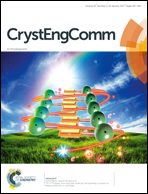Fabrication of one-dimensional Bi2O3–Bi14MoO24 heterojunction photocatalysts with high interface quality†
Abstract
Novel, one-dimensional Bi2O3–Bi14MoO24 heterostructures with high interface quality were synthesized by high temperature calcination of Bi2MoO6–Bi(OHC2O4)·2H2O precursors in air at 400 °C for 2 h. Bi14MoO24 grew on the Bi2O3 porous rods by crystallographic-oriented epitaxial growth, which increased the interface quality and then provided the smallest penetration barrier for electron–hole pair transfer between Bi2O3–Bi14MoO24 interfaces. The photocatalytic activity of the as-prepared products was evaluated by the degradation of methyl orange (MO) and phenol under solar/visible light irradiation. The results show that Bi2O3–Bi14MoO24 heterostructures display higher photocatalytic activity than that of the pure phase Bi2O3 and Bi14MoO24, and 100% phenol (10 mg L−1) can be degraded in 80 min under visible light irradiation using the Bi2O3–Bi14MoO24 (DS-2) heterostructure as photocatalyst. This enhanced photocatalytic performance is ascribed to the synergistic effect of the suitable band alignment of the Bi2O3 and Bi14MoO24, high interface quality and one-dimensionally ordered nanostructure. Radical scavenger experiments proved that the photogenerated holes and ˙O2− play key roles during the photodegradation process. This work offers an effective route to the design and fabrication of the junction structures with high interface quality for photocatalytic applications.


 Please wait while we load your content...
Please wait while we load your content...